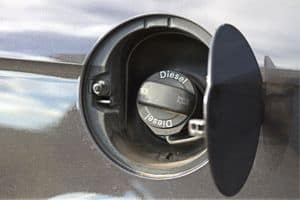Many vehicles run on diesel; perhaps you even own one. As you fill up at the pump, it might have crossed your mind that you have no idea whether diesel is flammable. Is this fuel source able to easy ignite?

Diesel is flammable, but not nearly to the same extent as gasoline. It usually takes prolonged exposure or high degrees of pressure to cause diesel to ignite.
If you want to learn even more about diesel, such as what it is, how flammable it is, and how to safely use it, this guide will tell you everything you need to know. Make sure you keep reading, as there’s lots of great information ahead!
Table of Contents
What Is Diesel?
Let’s start by talking about what diesel is.
Diesel oil or diesel fuel is a liquid source of fuel intended for diesel engines.
A diesel engine is different from other types of engines, as the ignition can occur even in the absence of a spark.
Instead, the inlet undergoes compression and receives fuel injection and that’s how a diesel engine starts.
Diesel fuel usually comes from petroleum oil as a fractional distillate. Gas-to-liquid, biomass-to-liquid, and biodiesel are becoming more popular as alternative fuel sources.
Ultra-low-sulfur diesel or ULSD is probably the alternate diesel source that’s gotten the most acclaim. This diesel fuel contains a much lower amount of sulfur than usual.
Thus, it’s no surprise that across North America and Europe, ULSD has been the primary source of diesel since 2006.
When ULSD diesel combusts, it releases much lower rates of emissions than burning regular diesel fuel.
What kind of vehicles use diesel? Large on-road vehicles such as buses and trucks still primarily rely on some source of diesel fuel to this day.
Heavy equipment such as tractors uses diesel, as do military vehicles and self-powered rail vehicles like railcars and locomotives.
Is Diesel Flammable?
To determine how flammable a substance is, we look at its flash point.
If you need a refresher, a flat point is the lowest temperature at which a liquid substance turns into a vapor and can be ignited.
So what’s the flash point of diesel?
Well, you’ll recall that there exist several types of diesel. Therefore, there’s no one flash point, but several.
The lowest flash point of diesel fuel is 125.6 degrees Fahrenheit or 52 degrees Celsius. The highest flash point is 199.4 degrees Fahrenheit or 93 degrees Celsius.
Any substance with a flash point lower than 140 degrees Fahrenheit or 60 degrees Celsius is flammable, and that would make diesel fuels flammable.
That alone might make you wary, but there’s not necessarily a reason to panic.
Diesel may be flammable, but to the same degree as say, gasoline? Not exactly.

The flash point of gasoline is -113 degrees Fahrenheit and -45 degrees Celsius.
Further, scientific resource Argonne National Laboratory states that “if you toss a lit match into a puddle of diesel fuel, it’ll go out.”
It’s not only that diesel isn’t as flammable as gasoline, although that’s certainly part of it. It’s also that diesel fuel must be exposed to a heat source such as a flame for a sustained period or receive intense pressure to ignite.
How to Safely Use Diesel
Although using diesel as a fuel source might be safer than gas since the former isn’t as flammable, that doesn’t mean that fueling up with diesel isn’t without its risks.
To wrap up, we want to share some safety tips for handling and filling up with diesel fuel.
Don’t Refuel When Your Vehicle Is Running
You might be used to filling up at the pump with your car ignition still on, but when handling diesel fuel, it’s best to turn your vehicle off. Further, give your car or truck additional time to cool down before pouring in the diesel fuel.
Don’t Breathe in the Fumes
Diesel is no friend of your lungs! If you breathe in the exhaust, you could feel lightheaded and nauseous. You also might start coughing and develop a headache.
Those are the short-term symptoms. Long-term exposure could possibly cause cancer, as diesel engine exhaust has been declared by the World Health Organization or WHO as a Group 1 carcinogen.
That makes sense when you consider all that’s in diesel exhaust. Here’s the list:
- Diesel particulate matter
- Polycyclic aromatic hydrocarbons
- Toluene
- Benzene
- Hydrocarbons
- Ketones
- Aldehydes
- Alcohols
- Sulphur oxides
- Nitrogen oxides
- Nitrogen
- Ammonia
- Water vapor
- Oxygen
- Carbon dioxide
- Carbon monoxide
- Soot
Never fuel up in an enclosed area, as you’re almost certain to breathe in the diesel exhaust. You might want to wear a mask when filling up just to be on the safe side.
Don’t Get Diesel on Your Skin
As if the above wasn’t bad enough, diesel fuel can also irritate the skin if direct exposure occurs. You could develop contact dermatitis such as redness, itchiness, and possibly a rash as well.
Do Not Store Diesel Near Sources of Flame or Heat
Diesel fuel is flammable, and thus you want to store it a good distance from sources of heat and flame, from heaters to engines.
Keep the Diesel Storage Area Clean
The less clutter in the area that can catch on fire, the better. Don’t leave rubbish and messes around, as you never know what could ignite in the right conditions!
Diesel fuel is flammable, although not as severely as gas. Even still, careful handling, avoidance of breathing in the fumes, and proper storage are key in preventing unintended fires and keeping yourself and your family safe!